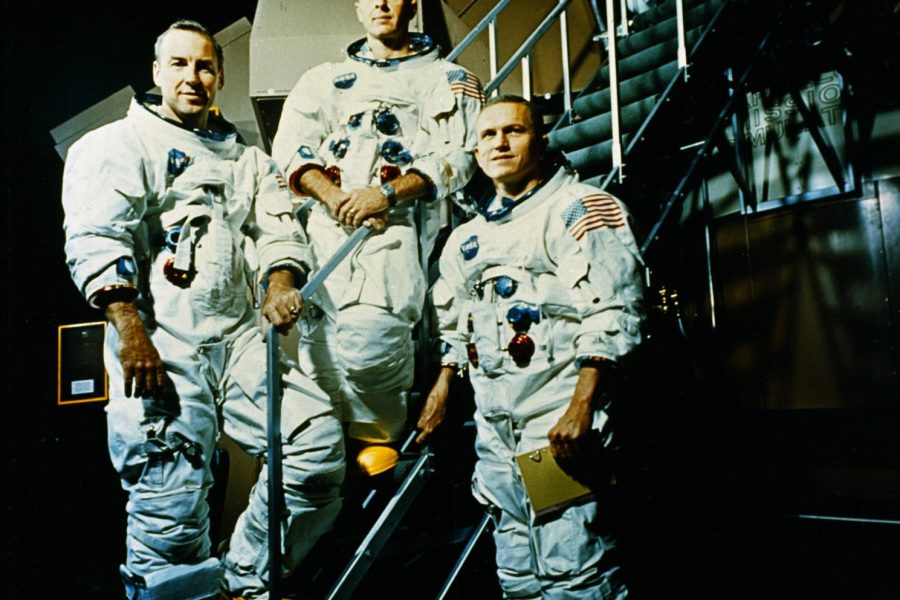Air Force Maj. Gen. William A. Anders, the Apollo 8 astronaut who, on the first mission to orbit the moon, took the iconic “Earthrise” photo—died June 7 when the aircraft he was flying alone crashed northwest of Seattle. He was 90.
Anders was an Air Force pilot, ambassador to Norway, member of the Atomic Energy Commission, and the first chair of the Nuclear Regulatory Commission. He worked in the aerospace industry, rising to lead the General Dynamics Corp. as Chief Executive Officer, restructuring the company after the end of the Cold War.
Passionate about military aircraft—he founded and was chairman of the Heritage Flight Museum in Washington state—Anders was flying a Beech T-34A Mentor when he crashed. His body was recovered; the FAA and the National Transportation Safety Board are investigating the accident.
Anders was born in Hong Kong in 1933 to a naval officer. The family, with young William in tow, survived Japanese attacks on China during WWII, including the close-by bombing of Nanjing.
He graduated from the U.S. Naval Academy in 1955 with a degree in electrical engineering but chose to accept an Air Force commission. After earning his wings, he served as an F-89 Scorpion pilot, flying with the 84th Fighter Interceptor Squadron in California and the 57th FIS in Iceland, participating in some of the first intercepts of Russian bombers approaching the U.S. He later returned to the 84th to fly the F-101 Voodoo.
Anders undertook a Master’s program in nuclear engineering through the Air Force Institute of Technology (AFIT) in 1958. It was a specialty assigned to him, though he had requested aeronautical engineering. So he concurrently studied aeronautical engineering, taking night classes at Ohio State University. He graduated with honors from AFIT in 1962 and was assigned to work on nuclear reactor projects with the Air Force Weapons Lab, maintaining his pilot proficiency as a part-time jet instructor.
In 1963, Anders applied to both the Air Force Aerospace Research Pilot School and NASA. He was chosen for the third group of astronauts, known as “The 14,” a class that included future moonwalkers such as Buzz Aldrin, David Scott, and Gene Cernan. Anders was among the few who had not already been a test pilot; it was the first group where it wasn’t required. He wasn’t accepted to the test pilot school.
Anders was picked to be the backup copilot for Gemini 11 and was then in line to fly Gemini 13, but the Gemini program was ended before that mission, having accomplished all its objectives.
Anders and Neil Armstrong were the first astronauts to fly the Lunar Landing Training Vehicle, or “Flying Bedstead,” a Lunar Module live-fly simulator powered by a vertically-mounted jet engine. Several crashed—Armstrong famously ejected from one only two seconds before it hit the ground—but pilots insisted it accurately matched the handling of the lunar module and should be retained.
As a spaceflight rookie, Anders was picked for the prime crew of the Apollo 8 mission, the original purpose of which was to test the lunar module in deep space; Anders was to be the lunar module pilot. However, intelligence indicated that the Soviet Union planned a two-man lunar orbit mission that could be construed as “winning” the space race to the moon, and the U.S. lunar module was not yet ready for flight, so Apollo 8 was reconceived as a lunar circumnavigation mission. Anders accepted the assignment, despite there being no lunar module for him to fly.
Anders, along with mission commander Frank Borman and command module pilot James Lovell, launched on Dec. 21, 1968. It was the first crewed flight of the giant Saturn V rocket.
The mission was the first to another celestial body, and the crew completed 10 orbits before firing their main engine and returning home. On one of the first orbits, Anders noticed the blue ball of the Earth coming up over the horizon and took the first color photo of this sight. The image has been hailed as one of the most iconic in the 20th century and was one of the inspirations for Earth Day.
Anders told Forbes Magazine in 2015 that the image pointed out the beauty of the Earth and “helped kick start the environmental movement.” He described the earth as looking like a shiny blue but fragile “Christmas ornament.”

The mission was also noteworthy in that the crew, during a live Christmas Eve broadcast, took turns reading passages from the biblical Book of Genesis.
After a year of traumatic events including the assassinations of Robert F. Kennedy and Martin Luther King, the Tet offensive in Vietnam, and race riots and divisive college demonstrations in the U.S., Apollo 8 was considered a rare bright spot in national and world affairs. NASA received a telegram after the mission, addressed to the crew, reading in part, “you saved 1968.” The crew was cheered with parades in major cities and made an address to a joint session of Congress.
Anders was assigned as the backup command module pilot for Apollo 11, the first moon landing mission, but after its success, did not believe he would get a chance to command a moon mission before the Apollo program ended. Upon exiting NASA, Anders remained in the Air Force Reserve.
He accepted an appointment from President Richard Nixon to be executive secretary of the National Aeronautic and Space Council, a cabinet-level panel chaired by Vice President Spiro Agnew. In that capacity, he developed multidepartment policy for national aeronautics and space development. The NASC’s recommendations were generally not implemented, however, and Anders recommended the panel be dissolved, which it was, in 1973.
Nixon then appointed Anders to the Atomic Energy Commission, where he worked on nuclear research and development policy, and on a détente-driven joint fission/fusion technology exchange program with the Soviet Union. The AEC was eventually split into two organizations: one to conduct nuclear power R&D and another to supervise commercial plants. Anders was appointed by President Gerald Ford to head the latter, the new Nuclear Regulatory Commission. He was credited with setting up the NRC’s processes and making its deliberations and decisions transparent to the public.
Anders was next appointed by Ford to be Ambassador to Norway, a post he held from 1976 to 1977.
He then entered the commercial world, heading General Electric’s Nuclear Products Division, supervising its nuclear plant operations. After a stint at the Harvard Business School, in 1980, Anders became head of GE’s Aircraft Equipment Division.
In 1984, Anders joined Textron, as executive vice president for aerospace, moving up in two years to senior vice president for operations. During this time he also consulted to the Office of Science and Technology Policy, the NASA Advisory Council and the Defense Science Board.
In 1988, he retired from the Air Force Reserve, having served 33 years.
He agreed to join General Dynamics as vice chairman in 1990 with the proviso that he could be a test pilot in the F-16, then made by that company. In 1991, he became chairman.
Anders was credited with turning General Dynamics around, shedding non-core divisions and operations and boosting its stock from under $20 a share to over $250. He succeeded at this despite the failure and termination of the A-12 stealth attack jet program for the Navy, on which GD was partnered with McDonnell Douglas. He arranged the sale of GD’s aircraft division to Lockheed for $1.5 billion in 1993, and then retired from day-to-management of the company, though he stayed on as chairman until 1994.
Soon after, he founded the Anders Foundation, an environmental education organization which in turn supported the many national parks foundations.
In 1996, Anders founded the Heritage Flight Museum, which flies 15 historic military aircraft and operates a museum of artifacts donated by veterans. Anders personally owned a P-51 Mustang, which he flew in air races, and he held as many as six flying records. He and Apollo 8 commander Frank Borman, who also owned and flew a P-51, would often occasionally fly their aircraft together at air shows.
Arizona Sen. Mark Kelly (D-Ariz.), a former Space Shuttle and International Space Station astronaut, issued a statement on social media saying that Anders “forever changed our perspective of our planet and ourselves” with the Earthrise photo, and “inspired me and generations of astronauts and explorers.”
NASA Administrator Bill Nelson said Anders “gave to humanity one of the deepest of gifts an explorer and an astronaut can give” with the Earthrise photo. He quoted Anders as saying “We came all this way to explore the Moon, and the most important thing is that we discovered the Earth.”
Nelson said Anders’ life was “the iron will of a pioneer, the grand passion of a visionary, the cool skill of a pilot, and the heart of an adventurer, who explored on behalf of all of us.”


